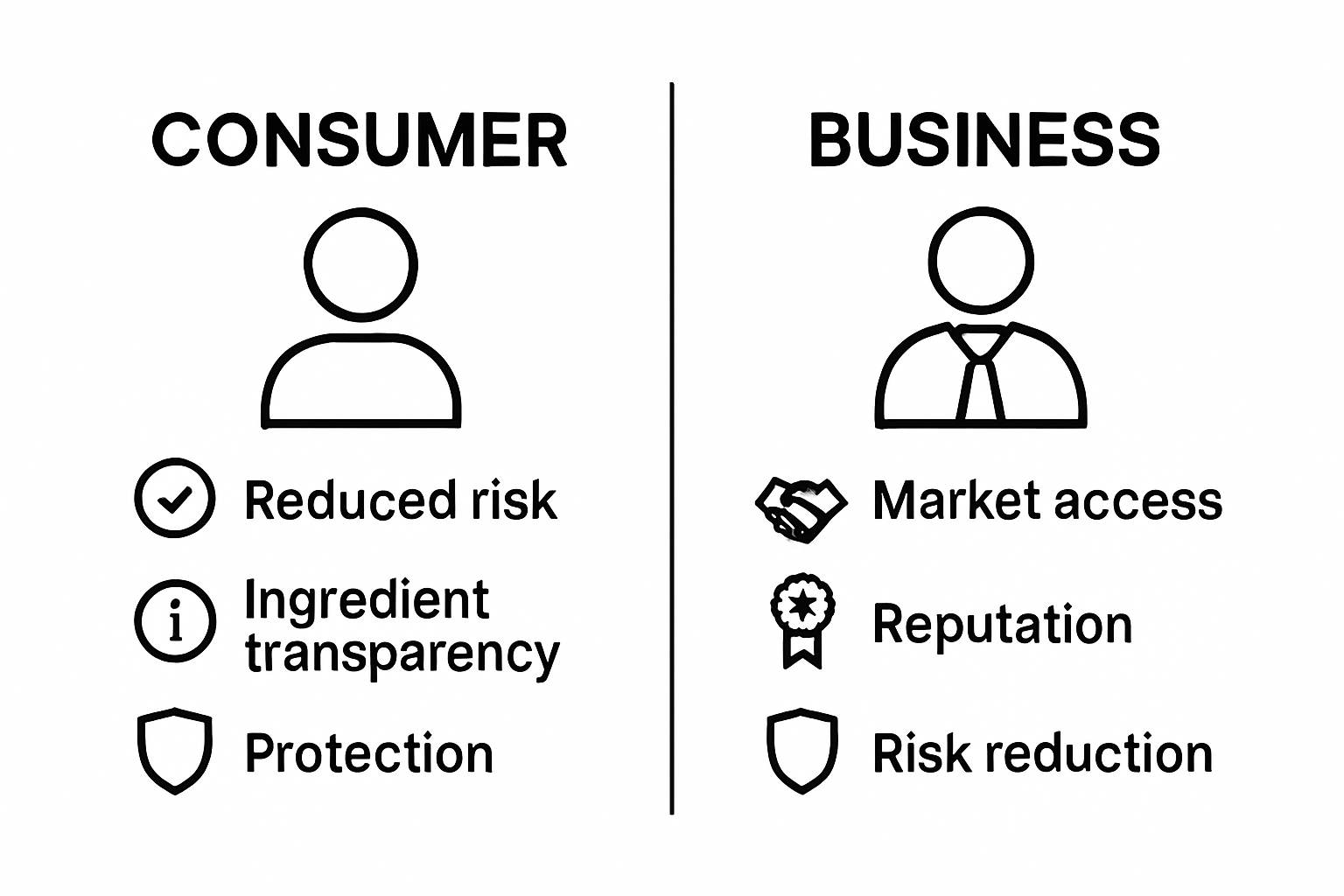
Les normes canadiennes en matière de salubrité des aliments comptent parmi les plus strictes au monde et encadrent chaque étape, des champs à l'assiette. La plupart des gens sont stupéfaits d'apprendre que des millions de personnes tombent malades chaque année à cause d'aliments contaminés, malgré ces mesures rigoureuses. Plus surprenant encore, au Canada, la principale garantie de la sécurité alimentaire ne repose pas uniquement sur les inspections, mais aussi sur une technique essentielle : l'évaluation scientifique des risques. Cette approche influence tous les aspects de votre alimentation et assure une sécurité alimentaire bien plus grande que vous ne le pensez.
Table des matières
- Quelles sont les réglementations en matière de sécurité alimentaire au Canada ?
- Pourquoi les réglementations en matière de sécurité alimentaire sont importantes pour les consommateurs et les entreprises
- Comment les réglementations en matière de sécurité alimentaire sont élaborées et appliquées
- Concepts clés de la réglementation en matière de sécurité alimentaire
- Défis et avenir de la réglementation en matière de sécurité alimentaire au Canada
Résumé rapide
| Emporter | Explication |
|---|---|
| La réglementation canadienne en matière de salubrité des aliments protège la santé publique. | Ces réglementations garantissent la qualité et la sécurité des aliments, de la production à la distribution, protégeant ainsi les consommateurs des risques sanitaires. |
| Santé Canada et l'ACIA dirigent l'élaboration de la réglementation. | Ces organismes collaborent pour créer et appliquer des normes de sécurité alimentaire qui atténuent la contamination et les risques sanitaires. |
| La conformité présente des avantages considérables pour les entreprises. | Le respect des réglementations favorise la confiance des consommateurs, améliore la réputation et ouvre l'accès à des marchés plus vastes. |
| Les contrôles préventifs sont essentiels à la sécurité alimentaire. | Il convient de privilégier l’identification des risques et la mise en œuvre de mesures avant qu’ils ne deviennent des menaces pour la santé, afin de garantir des chaînes d’approvisionnement alimentaire plus sûres. |
| Les défis technologiques exigent des réglementations adaptatives. | L’évolution rapide de la production alimentaire nécessite des mises à jour réglementaires pour gérer les nouveaux risques et maintenir les normes de sécurité. |
Quelles sont les réglementations en matière de sécurité alimentaire au Canada ?
Au Canada, la réglementation sur la salubrité des aliments constitue un cadre complet visant à protéger la santé publique en assurant la sécurité, la qualité et l’intégrité des produits alimentaires tout au long de la chaîne d’approvisionnement. Cette réglementation est élaborée et appliquée avec rigueur par de multiples organismes fédéraux, Santé Canada jouant un rôle central dans l’établissement de normes qui protègent les consommateurs contre les risques potentiels pour la santé.
Le paysage réglementaire
La réglementation canadienne en matière de salubrité des aliments couvre un large éventail d’aspects essentiels, axés sur la prévention de la contamination, la maîtrise des risques potentiels pour la santé et le maintien de normes élevées en matière de production et de distribution des aliments. Les principaux organismes de réglementation impliqués dans ce processus sont :
- Agence canadienne d'inspection des aliments (ACIA) : Responsable de l'application des politiques de salubrité des aliments
- Santé Canada : Élabore des normes alimentaires liées à la santé
- Agence de la santé publique du Canada : Surveille les éclosions de maladies d'origine alimentaire
Ces organismes collaborent à la mise en place d'un système performant qui couvre l'ensemble de la chaîne, de la production agricole à l'emballage et à la distribution des produits finis. Leur approche globale garantit que les produits alimentaires répondent à des exigences de sécurité strictes avant d'être mis à la disposition des consommateurs.
Vous trouverez ci-dessous un tableau récapitulant les principaux organismes fédéraux responsables de la salubrité des aliments au Canada et leurs rôles principaux, offrant ainsi un outil de référence rapide aux lecteurs.
| Nom de l'agence | Rôle principal |
|---|---|
| Agence canadienne d'inspection des aliments | Applique les politiques de sécurité alimentaire |
| Santé Canada | Élabore des normes alimentaires liées à la santé |
| Agence de la santé publique du Canada | Surveille les épidémies de maladies d'origine alimentaire |
Objectifs clés de la réglementation en matière de sécurité alimentaire
Les principaux objectifs de la réglementation canadienne en matière de salubrité des aliments sont multiples et visent à protéger la santé publique de façon globale. Cette réglementation a pour but de :
- Prévenir les maladies d'origine alimentaire grâce à un contrôle strict de la contamination
- Garantir un étiquetage alimentaire précis et des informations transparentes sur les ingrédients
- Établir des directives claires pour la manipulation, la transformation et le stockage des aliments
- Protéger les populations vulnérables des risques sanitaires potentiels
Grâce à la mise en œuvre de cette réglementation détaillée, le Canada maintient l'un des systèmes de salubrité des aliments les plus rigoureux au monde. Notre guide sur la réglementation des emballages alimentaires fournit des informations supplémentaires sur les exigences spécifiques que les fabricants et les distributeurs doivent respecter pour se conformer à ces normes exhaustives.
Pourquoi les réglementations en matière de sécurité alimentaire sont importantes pour les consommateurs et les entreprises
La réglementation en matière de sécurité alimentaire joue un rôle essentiel dans la protection des consommateurs et des entreprises en établissant des normes exhaustives qui garantissent la qualité des produits, la protection de la santé et la stabilité économique. Ces réglementations ne sont pas de simples exigences bureaucratiques, mais des mécanismes indispensables à la protection de la santé publique et au soutien de pratiques commerciales durables.
Protection et prévention pour les consommateurs
Pour les consommateurs, la réglementation en matière de sécurité alimentaire constitue une protection essentielle contre les risques sanitaires potentiels. L'objectif principal est de prévenir les maladies d'origine alimentaire, qui peuvent avoir des conséquences graves, voire mortelles. Selon l'Organisation mondiale de la Santé , des millions de personnes dans le monde souffrent chaque année de maladies d'origine alimentaire, ce qui rend indispensables des normes de sécurité rigoureuses.
Les consommateurs bénéficient de ces réglementations grâce à :
- Réduction des risques de contamination et de maladie
- Informations transparentes sur les ingrédients et la valeur nutritionnelle
- Confiance dans la sécurité des produits alimentaires achetés
- Protection des groupes de population vulnérables
Avantages économiques et opérationnels pour les entreprises
Les entreprises tirent des avantages considérables d'une réglementation stricte en matière de sécurité alimentaire. Le respect de cette réglementation ne se limite pas à éviter les sanctions, mais contribue également à instaurer la confiance, à préserver sa réputation et à accéder à de plus vastes opportunités de marché. L'application rigoureuse des normes de sécurité témoigne de professionnalisme et d'un engagement envers le bien-être des consommateurs .
Les principaux avantages commerciaux comprennent :
- Amélioration de la confiance des consommateurs et de la réputation de la marque
- Accès aux marchés nationaux et internationaux
- Réduction du risque de rappels de produits coûteux
- Protection juridique et atténuation des risques
Notre guide complet sur la réglementation des emballages offre un éclairage approfondi sur la manière dont les entreprises peuvent s'y conformer efficacement. En comprenant et en appliquant cette réglementation, les entreprises témoignent de leur engagement envers la qualité et la sécurité, favorisant ainsi des relations durables avec les consommateurs et la pérennité de leur activité.

Comment les réglementations en matière de sécurité alimentaire sont élaborées et appliquées
Au Canada, la réglementation en matière de salubrité des aliments constitue un système complexe et évolutif qui fait intervenir de nombreux organismes gouvernementaux, des recherches scientifiques et une consultation continue des parties prenantes. L’élaboration et l’application de cette réglementation exigent une approche globale et à plusieurs niveaux qui concilie la protection de la santé publique et sa mise en œuvre concrète pour les entreprises.
Processus de développement réglementaire
L’élaboration de la réglementation en matière de salubrité des aliments commence par des recherches et des consultations approfondies. Santé Canada pilote les premières étapes en recueillant des données scientifiques, en consultant des experts et en analysant les risques potentiels pour la santé. Selon Santé Canada , le processus d’élaboration de la réglementation comporte plusieurs étapes cruciales :
- Évaluation scientifique complète des risques
- Consultations des parties prenantes avec des experts du secteur
- Analyse des impacts économiques et sanitaires potentiels
- Élaboration de cadres réglementaires proposés
- mécanismes de consultation et de retour d'information publics
Mécanismes d'application et de conformité
L’application des règlements sur la salubrité des aliments relève principalement de l’Agence canadienne d’inspection des aliments (ACIA), qui utilise un système rigoureux de surveillance, d’inspection et de sanctions potentielles. L’agence veille à ce que les entreprises respectent les normes établies grâce à :
Ce tableau décrit les étapes du processus d'élaboration de la réglementation canadienne en matière de salubrité des aliments afin d'aider les lecteurs à visualiser le déroulement séquentiel allant de la recherche à la consultation publique.
| Étape | Description |
|---|---|
| Évaluation des risques scientifiques | Collecte de preuves et évaluation des risques potentiels pour la santé |
| Consultation des parties prenantes | Solliciter l'avis et les commentaires d'experts du secteur |
| Analyse d'impact | Évaluation des effets économiques et sanitaires |
| Réglementation de rédaction | Création de cadres réglementaires proposés |
| Examen et commentaires du public | Solliciter l'avis du public et affiner les règles |
- Inspections régulières des installations
- Exigences de déclaration obligatoires
- Protocoles de test et d'échantillonnage
- Suspensions de permis potentielles en cas de non-conformité
- Soutien éducatif aux entreprises
Notre guide détaillé sur la réglementation des emballages fournit des informations supplémentaires sur les exigences de conformité spécifiques. En adoptant une approche proactive et collaborative, les organismes canadiens de réglementation de la salubrité des aliments créent un système qui protège la santé publique tout en favorisant l’innovation et la croissance des entreprises.
Concepts clés de la réglementation en matière de sécurité alimentaire
La réglementation en matière de sécurité alimentaire repose sur des principes scientifiques rigoureux et des cadres stratégiques conçus pour protéger la santé publique et garantir l'intégrité des systèmes alimentaires. Cette réglementation va bien au-delà de la simple conformité ; elle représente une approche globale de la gestion des risques potentiels et du maintien de normes de qualité alimentaire élevées.
Évaluation des risques scientifiques
L’évaluation des risques est la pierre angulaire de la réglementation en matière de salubrité des aliments et consiste en une évaluation systématique des dangers potentiels pour la santé. Selon Santé Canada , ce processus comprend le repérage et l’analyse des risques biologiques, chimiques et physiques potentiels susceptibles de compromettre la salubrité des aliments.
Les principaux éléments de l'évaluation scientifique des risques comprennent :
- Identification des dangers
- Évaluation de l'exposition
- Évaluation dose-réponse
- Caractérisation des risques
- Suivi et examen continus
Principes de contrôle préventif
La réglementation moderne en matière de sécurité alimentaire privilégie la prévention aux mesures correctives. Cette approche vise à identifier et à atténuer les risques potentiels avant qu'ils ne deviennent des menaces importantes pour la santé. Le principe repose sur la mise en place de systèmes complets couvrant chaque étape de la production alimentaire, de l'approvisionnement initial à la distribution finale.
Les stratégies de contrôle préventif essentielles comprennent :
- Mise en œuvre de l'analyse des dangers et des points critiques pour leur maîtrise (HACCP)
- Mise en place de protocoles d'hygiène stricts
- Effectuer des inspections régulières des installations
- Tenir une documentation complète
- Garantir la traçabilité des produits alimentaires
Notre guide complet sur la réglementation des emballages offre un éclairage supplémentaire sur la manière dont ces principes préventifs sont appliqués tout au long du processus de production alimentaire. En comprenant et en mettant en œuvre ces concepts clés, les entreprises et les organismes de réglementation collaborent à la création d'un écosystème de sécurité alimentaire robuste qui privilégie la santé des consommateurs et la qualité des produits.

Défis et avenir de la réglementation en matière de salubrité des aliments au Canada
Au Canada, la réglementation en matière de salubrité des aliments évolue constamment afin de répondre aux nouveaux défis et aux transformations technologiques qui caractérisent le paysage mondial de la production alimentaire. Le caractère dynamique de cette réglementation reflète l’interaction complexe entre l’innovation scientifique, les attentes des consommateurs et les risques sanitaires émergents potentiels.
Défis technologiques émergents
Les progrès technologiques offrent à la fois des opportunités et des défis majeurs aux autorités de sécurité alimentaire. Le développement rapide des technologies de production alimentaire, notamment la modification génétique, l'intelligence artificielle dans la transformation des aliments et les techniques de fabrication avancées, exige une adaptation réglementaire constante. Selon des recherches récentes, les autorités doivent élaborer des cadres permettant d'évaluer et d'intégrer rapidement les nouvelles innovations technologiques tout en maintenant des normes de sécurité rigoureuses.
Les principaux défis technologiques sont les suivants :
- Adapter la réglementation aux nouvelles technologies de production alimentaire
- Gestion des risques associés aux modifications génétiques
- Mise en œuvre de systèmes de traçabilité avancés
- Répondre aux préoccupations en matière de cybersécurité dans les chaînes d'approvisionnement alimentaire
- Intégrer l'intelligence artificielle dans la surveillance de la sécurité
Interconnexion mondiale et complexité réglementaire
La mondialisation croissante des chaînes d'approvisionnement alimentaire complexifie sans précédent la réglementation en matière de salubrité des aliments. Le commerce international exige une harmonisation des normes entre les différentes juridictions, ce qui oblige les organismes de réglementation canadiens à concilier les exigences nationales en matière de salubrité et l'accès aux marchés internationaux.
Les considérations essentielles pour les futurs cadres réglementaires comprennent :
- Élaboration de normes réglementaires internationales flexibles
- Créer des mécanismes robustes de sécurité alimentaire transfrontaliers
- Lutter contre les effets du changement climatique sur la production alimentaire
- Gestion des perturbations potentielles de la chaîne d'approvisionnement
- Renforcer la collaboration internationale et le partage d'informations
Notre guide complet sur la réglementation des emballages apporte un éclairage supplémentaire sur la manière dont ces enjeux évolutifs sont relevés. Alors que la réglementation en matière de sécurité alimentaire continue de se transformer, l’objectif principal demeure inchangé : protéger la santé publique grâce à des approches novatrices, adaptées et fondées sur des données scientifiques.
Prêt à simplifier la conformité en matière de sécurité alimentaire et l'emballage des produits ?
Protéger vos clients et votre entreprise commence par la maîtrise des strictes réglementations canadiennes en matière de salubrité alimentaire. Cet article explique comment le respect rigoureux des normes, l'exactitude de l'étiquetage et la transparence des informations sur les ingrédients ne sont pas seulement des exigences légales, mais aussi des éléments clés pour instaurer la confiance des consommateurs. Si vous ressentez le poids d'assurer la sécurité et la clarté de l'emballage de vos produits alimentaires, sachez que vous n'êtes pas seul. De nombreuses entreprises canadiennes peinent à suivre l'évolution des normes et souhaitent avoir l'assurance que leurs produits sont prêts à être commercialisés.

Laissez Spaceman transformer la conformité réglementaire en atout concurrentiel. Fabricant et distributeur de confiseries lyophilisées de premier plan au Canada , nous proposons également des services d'étiquetage privé, de conditionnement à façon et d'ensachage professionnel, conformes aux normes de sécurité les plus strictes du Canada. Nous offrons des solutions complètes qui garantissent la conformité de vos produits à toutes les exigences réglementaires, vous permettant ainsi de vous concentrer sur la satisfaction de vos clients. Rendez-vous dès aujourd'hui sur space-man.ca et laissez-nous vous aider à réduire les risques de rappels coûteux tout en soutenant votre croissance sur les marchés en ligne et en magasin. N'attendez pas : anticipez les prochaines mises à jour réglementaires et assurez l'avenir de votre entreprise dès maintenant.
Foire aux questions
Quelles sont les principales réglementations en matière de sécurité alimentaire au Canada ?
Au Canada, la réglementation en matière de salubrité des aliments vise à prévenir la contamination, à garantir un étiquetage précis et à maintenir des normes élevées en matière de production et de distribution alimentaires. Les principaux organismes de réglementation sont l’Agence canadienne d’inspection des aliments (ACIA) et Santé Canada.
Pourquoi les réglementations en matière de sécurité alimentaire sont-elles importantes pour les consommateurs ?
La réglementation en matière de sécurité alimentaire protège les consommateurs en réduisant les risques de maladies d'origine alimentaire, en garantissant la transparence de l'étiquetage des ingrédients et en assurant la confiance dans la sécurité des produits alimentaires achetés.
Comment les réglementations en matière de sécurité alimentaire sont-elles appliquées au Canada ?
La réglementation en matière de salubrité des aliments est principalement appliquée par l’Agence canadienne d’inspection des aliments (ACIA), qui effectue des inspections des installations, surveille la conformité et peut imposer des sanctions en cas de non-conformité.
Quel rôle joue l'évaluation scientifique des risques dans la réglementation en matière de sécurité alimentaire ?
L'évaluation scientifique des risques est cruciale dans la réglementation en matière de sécurité alimentaire car elle évalue systématiquement les dangers potentiels pour la santé liés aux aliments, permettant ainsi l'identification et l'atténuation des risques avant qu'ils n'aient un impact sur la santé publique.

